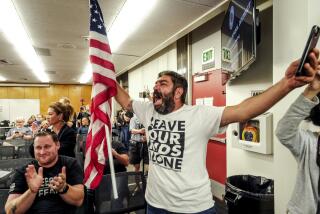Partner Notification Can Be Useful Tool Against AIDS Spread
- Share via
The American Medical Assn. and presidential AIDS commission have recently encouraged increased use of contact tracing (now also called “partner notification”) to reduce the spread of the human immuno-deficiency virus (HIV). To many people, especially in the gay community, contact tracing is very threatening. However, information about programs in Minnesota, South Carolina, Colorado and California has shown that partner notification can work as a small part of a major community AIDS prevention program.
The primary goals of contact tracing for HIV are to locate people who are unlikely to know that they may have been exposed to HIV, and to provide them with counseling on low-risk behavior and on the advisability of testing to see if they have been infected. For example, in large cities the primary target is usually women of childbearing age who may have had sexual contact or shared needles with infected men.
Because partner notification is both expensive and labor-intensive, every community sets priorities concerning whom to contact and counsel. In San Francisco, tracing is currently limited to partners of heterosexuals with AIDS going back to 1979. In Colorado, tracing is done only for partners within the past 12 months. In a rural South Carolina county, there was tracing from the only individual who tested positive, a gay man, but tracing was done only within that county.
Successful contact tracing can only be voluntary. No law or procedure can force someone to name contacts whom he or she “forgets.” Thus it requires a spirit of cooperation and trust between public-health officials and the community.
Confidentiality must be guaranteed. This means that people are notified and counseled in person. Sometimes, after several failures to locate someone in person, efforts are made by telephone or letter but only to set up an in-person private meeting. No information about the reason is provided by phone or mail. Proof of identity is then required before information about likely exposure is given. A person is never told who gave his or her name as a contact. It is only because of this provision that some people have sought assistance in notifying prior partners whom they were unwilling or unable to notify themselves.
The fear that gay bisexual men have is that someone will approach them at work or home and expose their sexual orientation, resulting in loss of job and/or family disruption. This does not happen in successful programs, and guarantees must be established within programs to be certain that it does not happen.
Contact tracing is expensive--$810 to identify an infected individual in South Carolina (compared to $500 at a government-funded test site) and $2,203 in San Francisco. Because of the cost it is obvious that only a small number of people can be reached this way. Thus widespread community prevention programs and anonymous testing programs must continue to be the major focus of AIDS prevention. In South Carolina, the good news is that the gay men who were intensively counseled after contact tracing had a marked increase in condom usage for anal intercourse. This is the only study showing that contact tracing results in behavioral change. All programs need an evaluation to see if they are effective, not just in identifying people but in reducing high-risk behavior as well.
Many people at increased risk for AIDS--gay and bisexual men, IV drug users, and blacks and Latinos, who make up the vast majority of heterosexual AIDS cases--have good reason to mistrust governmental authority. Public-health officials in any community contemplating a partner-notification program need to meet with representatives of these at-risk groups as well as with women’s groups, since women of child-bearing age are likely to be a top priority for tracing in all communities. Information about the methods of contact tracing and procedures for guaranteeing confidentiality must be discussed.
Politicians, physicians and others who treat contact tracing as a punitive measure must be encouraged to stop such behavior because it leads to further distrust and can destroy the effectiveness of a contacttracing program.
If the resources and personnel are made available and if confidentiality is guaranteed, then with community cooperation a successful partner-notification program can save lives. However, an improper program can destroy lives. The choice is obvious.
More to Read
Sign up for Essential California
The most important California stories and recommendations in your inbox every morning.
You may occasionally receive promotional content from the Los Angeles Times.












